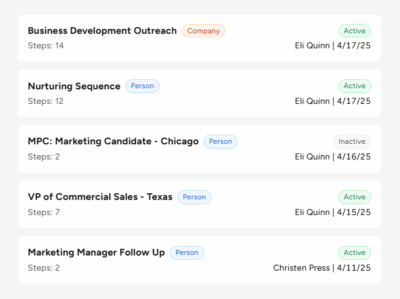Imagine you’re an applicant excited about a new job opportunity at a company that aligns with your career goals. You put time and effort into crafting your application, tweaking your resume, and writing a compelling cover letter. You click submit, hopeful for a positive response, but then—nothing. No acknowledgment, no follow-up, and no indication of what happens next. This scenario is all too common, and it reflects a significant gap in many companies’ hiring processes. The problem? Communication! (Or the lack thereof.)
What some employers fail to realize is that candidates expect more than just a one-way interaction. They anticipate acknowledgment of their application, updates on their status, and clarity about next steps. This expectation isn’t just about courtesy; it’s about respect and communication. When employers fail to provide this, they risk “ghosting” their applicants—a term borrowed from the dating world that describes the sudden, unexplained cessation of communication.
Ghosting isn’t just frustrating for job seekers; it can also harm an organization’s reputation and bottom line. In this article from Top Echelon Recruiting Software, let’s explore why effective communication with applicants is critical, how poor communication can impact your brand, and what tools like Top Echelon Software can do to help you create a positive candidate experience.
Why Communication Matters: The Impact of Poor Candidate Experience
A job application is often a candidate’s first interaction with your company, and how they are treated during this process significantly shapes their perception of your organization. Failing to communicate with applicants can have wide-reaching negative effects that extend beyond the hiring process.
Damaging Your Employer Brand
In today’s interconnected world, word travels fast. A single negative experience can quickly become public through social media, online reviews, or word of mouth. Candidates who feel ignored or mistreated are likely to share their frustrations, potentially deterring other talented individuals from applying to your company. Negative reviews on platforms like Glassdoor can damage your employer brand, making it harder to attract quality candidates in the future.
Impact on Customer Loyalty and Revenue
A poor candidate experience doesn’t just affect your talent pool; it can also hurt your business’s bottom line. If job seekers have a negative impression of your company during the hiring process, they may decide not to support your business as customers. For example, a retail company that fails to communicate respectfully with applicants might lose not only potential employees but also loyal customers who decide to shop elsewhere.
Creating a Competitive Disadvantage
Top talent often has multiple opportunities available, and a frustrating application process can quickly drive them toward your competitors. In a tight job market, where candidates are in high demand, ensuring a smooth and positive recruitment experience can be the difference between attracting the best talent or losing them to more responsive employers.
Best Practices for Improving Applicant Communication
The key to avoiding ghosting is establishing a consistent and thoughtful communication strategy throughout the hiring process. A good applicant tracking system (ATS) like Top Echelon offers numerous tools to help streamline communication, keep candidates informed, and create a positive experience. Below are best practices that can transform your recruiting process and enhance the candidate experience.
1. Acknowledge Every Application: Start the Relationship on the Right Foot
Acknowledging an application is the simplest yet most powerful way to start building a positive relationship with a candidate. This first touchpoint reassures applicants that their effort has been recognized and sets the tone for further communication.
Automated Acknowledgment Messages
Implement automated messages that immediately acknowledge receipt of an application. These messages can appear directly on the application portal or be sent via email. A simple “Thank you for applying” message not only confirms that their application was received but also provides a brief outline of the next steps, helping to manage candidate expectations from the beginning.
Personalizing the Acknowledgment
Where possible, personalize your messages to make them feel less robotic and more engaging. For example, including the applicant’s name, a note about the role they applied for, or a brief statement about your company’s excitement to review their application can make a big difference. This small touch helps humanize the process and fosters a positive connection from the outset.
2. Communicate Rejections Promptly and Respectfully: Closing the Loop
Rejection is an inevitable part of the hiring process, but how you handle it can significantly impact your company’s reputation. When candidates invest time in applying for a job, they deserve to know the outcome, even if it’s not what they hoped for.
Timely Rejection Messages
Ensure that candidates who are not moving forward receive a prompt rejection message. Delayed or missing communication leaves applicants in limbo, causing frustration and potentially damaging their view of your organization. Aim to send rejection emails as soon as a decision is made, even if it’s early in the screening process.
Offer Constructive Feedback
While automated rejection messages are convenient, consider offering constructive feedback to candidates who make it to the later stages of the interview process. Providing insight into why they were not selected, along with encouragement to apply for future opportunities, shows respect for their efforts and leaves them with a positive impression of your company.
Sample Rejection Message
“We appreciate your interest in [Company Name] and the time you invested in the application process. Although we have decided to move forward with other candidates, we were impressed with your skills and encourage you to stay connected with us for future opportunities.”
3. Create a Transparent Hiring Workflow: Setting Clear Expectations
Candidates value transparency and want to know what to expect during the hiring process. By clearly outlining your workflow and communicating what happens at each stage, you can reduce anxiety and keep candidates engaged.
Outline the Hiring Stages
From the initial application to the final interview, provide candidates with a clear overview of each step in the hiring process. This could be communicated in the initial acknowledgment email or through a dedicated section on your career site. For example, you could include information about how many interview rounds to expect, typical timelines, and who they will be meeting.
Communicate Regular Updates
Keeping candidates informed of their status is crucial. If a decision is taking longer than expected, send a brief update to let them know they’re still being considered. Regular touchpoints, even if there’s no new information, demonstrate that you value the candidate’s time and are committed to maintaining communication.
4. Use Automation to Enhance, Not Replace, Personal Touchpoints
Automation is a powerful tool that can streamline communication, but it should complement—not replace—the human element of recruiting. Striking the right balance between automated updates and personal engagement is key to maintaining a positive candidate experience.
Triggered Emails for Key Milestones
Leverage your ATS to create triggered emails for specific milestones, such as when an applicant passes a screening stage or is moved to the next interview. These automated messages keep candidates informed without requiring manual intervention, ensuring that no one is left in the dark.
Personalized Outreach for Key Interactions
For more critical interactions, such as interview scheduling or providing feedback, personalized communication should take precedence. A phone call or personalized email from the recruiter adds a touch of care that automation alone cannot achieve, showing candidates that they are more than just a number.
5. Maintain a Talent Pipeline: Staying in Touch with Potential Future Hires
Just because you don’t hire a candidate now doesn’t mean they won’t be a great fit in the future. Maintaining a talent pipeline allows you to keep in touch with promising candidates and engage them for future opportunities.
Build a Searchable Candidate Database
An ATS like Top Echelon can help you build and manage a searchable database of past applicants. Tag candidates based on their skills, qualifications, and job preferences, making it easy to revisit their profiles when new roles become available. This proactive approach ensures you have a ready pool of talent to draw from, reducing time-to-hire.
Reconnect with Candidates
Regularly reconnect with candidates in your database by sending personalized messages or updates about new job openings. This ongoing engagement helps keep your company top of mind and increases the likelihood that they will consider your opportunities in the future.
6. Avoid Ghosting: Treat Every Candidate Interaction with Respect
Ghosting applicants can severely damage your reputation and deter future candidates from engaging with your brand. To build a respectful hiring process, commit to communicating consistently, transparently, and professionally at every stage.
Set Internal Standards for Communication
Establish clear internal standards for how and when your team communicates with candidates. This might include specific timeframes for responding to applications, guidelines for personalized feedback, and protocols for keeping candidates updated throughout the process. Holding your team accountable to these standards ensures a consistent and positive candidate experience.
Use Technology to Stay Organized
Technology plays a crucial role in managing communication efficiently. Use your ATS to track where each candidate is in the hiring process, set reminders for follow-ups, and automate standard communications. By staying organized, you can prevent oversights and ensure that every candidate receives the attention they deserve.
Communication: The Final Word
Providing a positive candidate experience is not just about filling positions; it’s about building lasting relationships and maintaining your company’s reputation as an employer of choice. By acknowledging applications, communicating rejections respectfully, creating transparent workflows, and using technology to enhance communication, organizations can avoid the pitfalls of ghosting and create a respectful and engaging hiring process.
With the right tools and strategies in place, you can ensure that every candidate—whether hired or not—leaves with a positive impression of your company, increasing the likelihood that they will speak highly of your brand and engage with future opportunities. If you need assistance enhancing your candidate communication strategy, reach out to Top Echelon Software to learn how our solutions can support your recruiting efforts.








